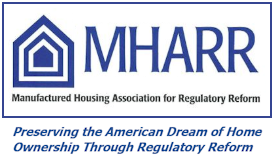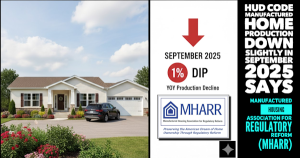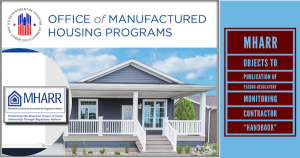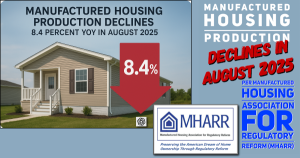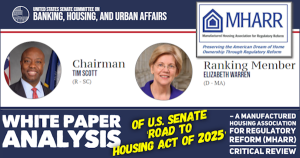Washington, D.C.
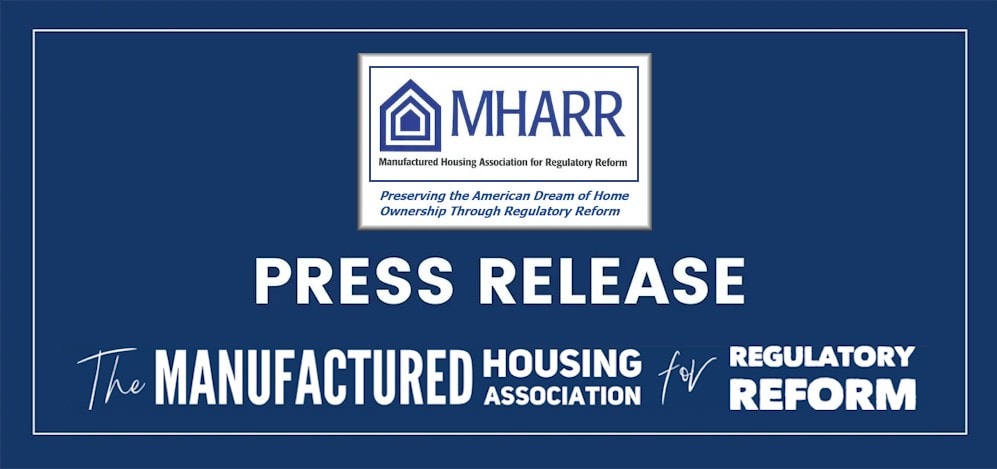
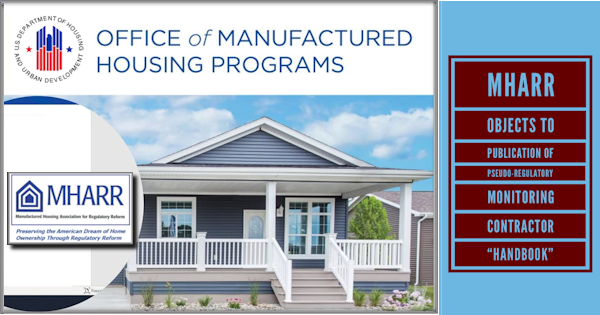
OCTOBER 20, 2025
TO: HUD CODE MH INDUSTRY MANUFACTURERS
FROM: MHARR
RE: MHARR OBJECTS TO PUBLICATION OF PSUEDO-REGULATORY MONITORING CONTRACTOR “HANDBOOK”
The Manufactured Housing Association for Regulatory Reform (MHARR), in an October 15, 2025, communication (see, copy attached), has called on the Administrator of HUD’s Office of Manufactured Housing Programs (OMHP), to block the publication of a “State Administrative Agency Functions Handbook” (Handbook) by OMHP’s “monitoring” contractor, the Institute for Building Technology and Safety (IBTS). During a presentation at HUD’s recently-concluded SAA-PIA conference, an IBTS panel indicated that the new Handbook was due for imminent publication, on or about October 1, 2025. At present, it does not appear that the Handbook has yet been released.
At the conference, MHARR objected to the publication of any such “Handbook” without full compliance with applicable regulatory procedures as mandated by the Manufactured Housing Improvement Act of 2000 (2000 Reform Law). HUD stated, at that time, that it would include a “disclaimer” with the Handbook, indicating that the contents are not per se “regulations.” MHARR maintained its objection, however, noting that the Handbook contents would nevertheless be viewed by regulated parties as binding pseudo-regulatory statements. At the heart of this objection is the history of such pseudo-regulatory mandates within the HUD manufactured housing program — and their principal beneficiary/sponsor, HUD’s entrenched 50-year “monitoring” contractor – which demonstrated to MHARR the need to update and reform the regulatory procedural requirements of the original National Manufactured Housing Construction and Safety Standards Act of 1974.
MHARR’s communication of October 15, 2025, accordingly, documents and amplifies these objections, noting that a HUD “disclaimer” would do nothing to avoid the reality of pseudo-regulatory impacts and that under the enhanced regulatory procedures of the 2000 Reform Law, any pronouncement involving an “interpretation” of either the standards or Procedural and Enforcement Regulations (PER) (or placing a gloss on those regulations) must be brought first to the statutory Manufactured Housing Consensus Committee (MHCC) for review and approval – which has not occurred in this case. Indeed, MHARR points out that HUD’s failure to follow regulatory procedures for IBTS’ pseudo-regulatory 1980s “Acceptable Quality Level” (AQL) criteria, which it deemed “recommendations” while noting that third-parties would be evaluated based on those “recommendations,” was the impetus that led to the 2000 Reform Law requirement that all such pseudo-regulatory statements be reviewed by the MHCC and then published for notice and comment (as explained above).
MHARR’s communication, therefore, calls on HUD to either submit the IBTS Handbook for MHCC review, or bar its publication and distribution.
MHARR will continue to closely monitor this matter and will update you as circumstances warrant.
cc: Other Interested HUD Code Manufactured Housing Industry Members
Attachment
—
October 15, 2025
VIA FEDERAL EXPRESS
Ms. Mary Jo Houton
Administrator
Office of Manufactured Housing Programs
U.S. Department of Housing and Urban Development
451 7th Street, S.W.
Washington, D.C. 20410
Re: IBTS SAA Functions Handbook
Dear Ms. Houton:
At a presentation made on September 23, 2025, as part of HUD’s State Administrative Agency (SAA)-Primary Inspection Agency (PIA) conference, speakers from the federal manufactured housing program’s entrenched “monitoring” contractor, the Institute for Building Technology and Safety (IBTS), referenced and summarized a “State Administrative Agency Functions Handbook” (see, Attachment 1 hereto) that IBTS planned on making available as of October 1, 2025. According to that same presentation and contemporaneous statements by you and other HUD manufactured housing program officials, the aforesaid Handbook is not being produced as a “deliverable” under the HUD monitoring contract. Further, it was stated that HUD would include a “disclaimer” with this publication, stating that it is not official and does not constitute a statement of law or regulation.
As I publicly stated at that time, however, the publication and distribution of this “Handbook” without any other or further administrative procedure by HUD under the National Manufactured Housing Construction and Safety Standards Act of 1974 (1974 Act), as amended by the Manufactured Housing Improvement Act of 2000 (2000 Reform Law), would represent a gross violation of applicable law and abuse of the position and status of the “monitoring” contractor. Accordingly, the “Handbook” must either be submitted to the statutory Manufactured Housing Consensus Committee (MHCC) for review and consideration, or totally withdrawn and abandoned.
A publication of the sort described by IBTS is not unprecedented in the history of the federal program. In March 1985, James C. Nistler, HUD’s Deputy Assistant Secretary for Single Family Housing (DAS), published a series of memoranda, without notice and comment rulemaking, outlining circumstances under which there would be an increased frequency of IPIA monitoring under “Acceptable Quality Level” (AQL) criteria developed by the very same monitoring contractor. In a subsequent April 11, 1985 memorandum to all PIAs (see Attachment 2 hereto), DAS Nistler stated:
“To assist the IPIAs in their compliance with the regulatory requirement[s], memos were issued on March 4 and 29, 1985 which set forth a schedule for increasing inspections…. However, I have recently been advised by HUD’s Office of General Counsel that there is a question as to whether the directives contained in these memos should have been published in the Federal Register. Therefore … the March 4 and 29 memos should be treated by IPIAs as recommendations, rather than mandatory requirements.”
(Emphasis added). The same document then went on to state, however:
“The Department regularly assesses the adequacy of IPIA performance. The IPIAs judgment as to when and how to increase production surveillance and take other remedial action at plants with inadequate quality control plays an important part in the Department’s evaluation of an IPIAs performance. Adherence to the recommendations contained in the March 4 and March 29 memos will ensure that this IPIA will receive an acceptable rating with respect to this function.”
(Emphasis added).
Effectively, then, HUD stated that the measures set forth in the March 1985 memoranda were mere “recommendations,” and, therefore, not officially binding or mandatory, but that adherence to those erstwhile “recommendations” would determine and govern IPIA evaluation by HUD (and its monitoring contractor).
This effort to circumvent the rulemaking requirements of the 1974 Act led to litigation by MHARR and others, but, more importantly, led to the sweeping rulemaking and consensus requirements of the 2000 Reform Law. In particular, section 5403(b) of the 2000 Reform Law (42 U.S.C. 5403(b)) makes it abundantly clear that any action involving an interpretation of either the Federal Manufactured Home Construction and Safety Standards (FMHCSS) or the Part 3282 Procedural and Enforcement Regulations (PER) must be submitted to the statutory Manufactured Housing Consensus Committee for review and then published for notice and comment before taking effect. This section was specifically designed to prevent backdoor rulemaking via “interpretation,” unless and until any such “interpretation” was considered and approved by the MHCC and subjected to full rulemaking procedures.
This same provision would prohibit any action by the program “monitoring” contractor to unilaterally interpret or place any type of gloss on the Part 3280 standards or PER regulations as part of a “Handbook” or any other type of allegedly “non-regulatory” or “sub-regulatory” publication. Quite simply, and as I stated at the conference, any type of statement by the monitoring contractor (i.e. HUD’s contract agent) regarding either the standards or the PER regulations and related procedures – whether deemed a “deliverable” under the monitoring contract or not and whether subject to a written disclaimer by HUD or not – would inevitably be received and considered by SAAs, PIAs and manufacturers as a de facto statement of law, or regulation, or enforcement protocol with respect to the procedures that they must follow as part of the federal program. Nor would this tendency and effect be negated by a supposed HUD “disclaimer.”
Consequently, the publication of any such “Handbook” by the monitoring contractor (or any other participant in the HUD manufactured housing regulatory system), must either be abandoned in whole or the entire publication must be submitted to the MHCC for consideration, consensus review and other required procedures.
Frankly – and particularly in light of our recent introductory meeting which was largely positive – we are astounded and disappointed that you would allow the monitoring contractor to engage in actions that the 2000 Reform Law was specifically designed to prevent. With manufactured housing production levels in recent decades lower than industry historical norms, it is not surprising that the 50-year monitoring contractor might seek to insinuate make-work activity into the regulatory system. In the context of a Trump Administration, however, that has recognized the importance of small business and is focused on increasing the supply of genuinely affordable housing and homeownership, such a project should – and must – be a non-starter.
Again, any statement by the program monitoring contractor – particularly given its entrenched status for the entire 50-year history of the federal program and longstanding industry concerns over regulatory abuse – carries, at a minimum, the implicit regulatory authority of HUD. Accordingly, the IBTS “Handbook” must be withdrawn and cancelled explicitly by HUD.
Sincerely,
Mark Weiss
President and CEO
cc: Hon. Scott Turner
Manufactured Housing Consensus Committee Members
HUD Code Manufactured Housing Industry Manufacturers
Attachments
